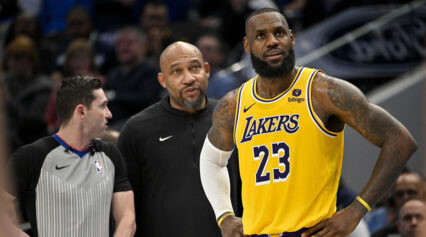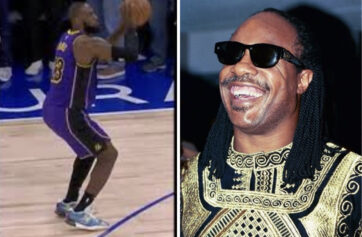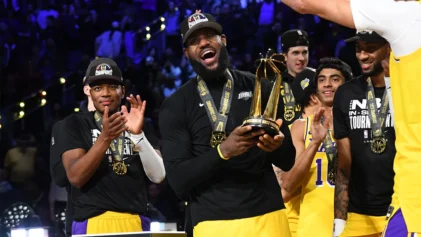On Wednesday the NBA Board of Governors voted to approve tougher resting police rules for star players sitting out home games, national TV games, in-season tournament games, and multiple star players on one team sitting games together. The new rule gives the league office the authority to fine teams up to $1 million per offense. This new rule is draconian, absolves the league from addressing the real issue, and it won’t stop anything.
New Media Rights Deal On The Table
Let’s start with some facts.
The next big hurdle for NBA commissioner Adam Silver is negotiating the league’s next broadcast deal. The current deal expires at the end of the 2024-25 season. According to reports the league is looking for as much as $75 billion on the next deal which would last eight or nine years.
Here’s the problem. The NBA’s regular season games are declining in ratings and have been for quite some time. Playoff ratings are down as well, but peak when star teams and players are involved. There are a variety of reasons why the regular season ratings are down. Yes, more viewing options and cable cord cutting are factors. But the biggest factor is the regular season is too long.
NBA Season Is Too Long
Over 82 games how do you expect to keep the casual fan’s interest when you are competing for mindshare with an infinite amount of options.
The NFL crushes the NBA in ratings for three reasons: Scarcity, a team only plays 18 games. Violence, this is America and we love our violence. Gambling, the nature of the game allows for a myriad of micro bets, in game live betting, fantasy, etc. It’s all tied to the fact that there are 18 weeks and in a given week, teams play one game.
Notice there was no mention made of the actual quality of the game. That’s irrelevant. Ratings prove that America will watch horrible football, because it’s football.
The scarcity also allows football to own days of the week. They own Sunday, Monday and Thursday, with the latter two only featuring one game.
In the NBA there is a game on every night. Even if you follow one team, sometimes your team plays up to five games in seven nights. No busy functioning person with responsibilities, unless they cover the league, can tune in to that many games.
When two-thirds of the league make the playoffs and play-in, it devalues the regular season.
The 44-38 Miami Heat not only made the play-in, won it and the playoffs. They advanced to the NBA Finals.
On the one hand that shows the value and popularity of the play-in tournament.
On the other, if each team only played 58 games, there wouldn’t be any time to waste or prolonged spells of .500 basketball. Teams like that wouldn’t qualify. Playing each team only twice, puts a much greater sense of urgency on the regular season.
A 58 game season over the course of seven months also allows the league to own two nights of the week. They could play games on Tuesdays and Saturdays. Now you create a sense of urgency.
If the Lakers and Warriors only play twice and you know it’s set for a Tuesday or Thursday, you can plan to make that appointment viewing.
Let the NBA tell it, and ratings will be fixed if star players played more. That narrative is dangerous. The average fan thinks that healthy superstar players are sitting out games just because. Nothing could be further from the truth. No player wants to sit. They are told to by the team, based on a myriad of factors. The main one being current injury and likelihood of an injury based on data being interpreted.
When you have an 82-game regular season, playoffs, and international basketball crammed into a 12-month period injuries are going to happen. Basketball is a contact sport, so no matter how many games you play injuries will happen. However, these soft tissue, non-contact injuries that are so tricky and difficult to heal, will reduce. Tired players move poorly. Poorly moving players increase their risk of injury.
The goal is never no injuries, that’s not possible. The goal is to deliver as many healthy bodies through the regular season and to the playoffs as possible.
Rules And Fines System
So in their infinite wisdom the NBA and the Board of Governors have come up with a set of rules and a fine schedule.
The fines system for teams begins with $100,000 for first offenses, $250,000 for second offenses and $1 million more than the previous penalty for each additional fine.
The rules are as follows:
- Teams must manage their roster to ensure that no more than one star player is unavailable for the same game. For example, the Phoenix Suns would not be allowed to rest both Devin Booker and Kevin Durant in the same game unless they are both injured.
- Teams must ensure that star players are available for national television and in-season tournament games.
- Teams must refrain from any long-term shutdown — or near shutdown — when a star player stops participating in games or plays in a materially reduced role in circumstances affecting the integrity of the game.
- Teams must maintain a balance between the number of one-game absences for a star player in home games and road games — with a preference for those absences to happen in home games.
- Teams must ensure that healthy players resting for a game are present and visible to fans.
A star player is defined as any player that made an All-NBA team or All-Star team in the previous three seasons.
Speaking of, these new rules also align with another new rule. In order for players to be eligible for season awards and All-NBA teams, they must meet the 65-game minimum threshold.
If a team’s medical and performance staff says star player X is at a 35% chance of pulling a hamstring or straining a calf, that team’s governor, general manager and head coach will be having a conference about sitting said star player. They will make sure the injury report says whatever it needs to, to avoid fines. Smart teams will anyway.
Governors have max contracts tied to these players, they don’t want to see their season and money go up in flames over something that could have been avoided with rest.
Does it suck if star player X is told to sit out a road game in a city he’ll only visit once for the season? Yes. That’s too bad for the fans who pay money and want to see star player X. But that’s the nature of sports. Yes, fans matter. We all know this.
But if there is no product on the floor or the product is terrible, fans aren’t going to pay anyway.
I’ve written and spoken at length on numerous platforms, including this one, on how a shortened regular season is better for fans, players, and everyone. Including top-of-mind ideas on how to “make up the lost revenue.”
No it won’t be easy to pull off, and people hate change. But if it is change that will ultimately make the product and experience better for everyone, why not?
Star players resting is not anywhere near the top of the list of issues the NBA has. Fixing its regular season, changing the way its broadcast partners and mainstream media talk about the product and how the game is marketed are of far greater importance.
But those are difficult, big mountain-size problems. It’s much easier to blame players and invoke a set of fines for resting.



